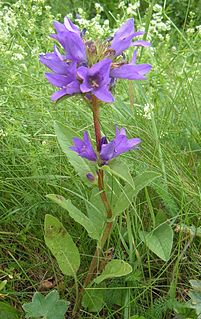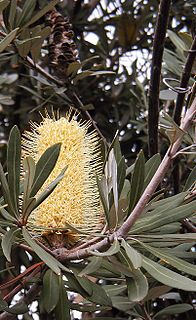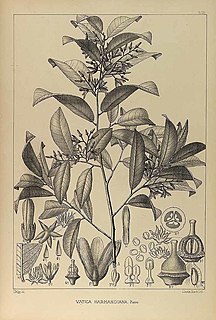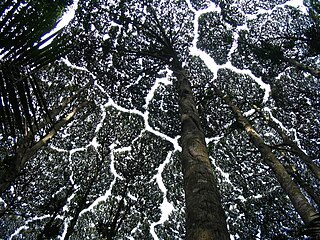
The Dipterocarpaceae are a family of 16 genera and about 695 known species of mainly tropical lowland rainforest trees. The family name, from the type genus Dipterocarpus, is derived from Greek and refers to the two-winged fruit. The largest genera are Shorea, Hopea, Dipterocarpus, and Vatica. Many are large forest-emergent species, typically reaching heights of 40–70 m, some even over 80 m, with the tallest known living specimen 93.0 m tall. The species of this family are of major importance in the timber trade. Their distribution is pantropical, from northern South America to Africa, the Seychelles, India, Indochina, Indonesia, Malaysia and Philippines. The greatest diversity of Dipterocarpaceae occurs in Borneo. Some species are now endangered as a result of overcutting, extensive illegal logging, and habitat conversion. They provide valuable woods, aromatic essential oils, balsam, and resins, and are a source for plywood.

Alnus incana, the grey alder or speckled alder, is a species of tree in the birch family, with a wide range across the cooler parts of the Northern Hemisphere.
Cotylelobium melanoxylon is a tropical rainforest tree found in Maritime Southeast Asia. The name melanoxylon is derived from Greek and describes the dark heartwood. It is a very good quality timber, as it has very hard and heavy as well as durable wood. C. melanoxylon is a tall emergent tree, up to 60 m, found in mixed dipterocarp forest on yellow sandy soils. It also occurs as a smaller canopy tree in kerangas forest on podsols. The tree occurs in at least three protected areas. Local names of the tree include Resak tembaga in Malay and Khiam (เคี่ยม) in Thai. The tree is the provincial symbol tree of Surat Thani Province, Thailand.

Campanula glomerata, known by the common names clustered bellflower or Dane's blood, is a species of flowering plant in the genus Campanula, belonging to the family Campanulaceae. It is the county flower of Rutland, England.

The taxonomy of Banksia integrifolia has a long and complex history, the result of confusion caused by the species' great variability, and similarities with some closely related species. The existence of hybrids between B. integrifolia and related species as well as early attempts to classify the species based on dried specimen material have also contributed to the confusion.

Hopea is a genus of plants in the family Dipterocarpaceae. The genus was named after John Hope, 1725–1786, the first Regius Keeper of the Royal Botanic Garden, Edinburgh. It contains some 113 species, distributed from Sri Lanka and southern India to southern China, and southward throughout Malesia to New Guinea. They are mainly main and subcanopy trees of lowland rainforest, but some species can become also emergent trees, such as Hopea nutans.
Shorea cordata is a species of plant in the family Dipterocarpaceae. The species name cordata is derived from Latin and refers to the shape of the leaf base.
Shorea dealbata is a species of plant in the family Dipterocarpaceae. The species name is derived from Latin and refers to the pale undersurface of the leaf.

Vatica harmandiana, also known by the synonym Vatica cinerea, is a species of plant in the family Dipterocarpaceae. It is a smallish tree native to Southeast Asia. It is the most common plant species in certain types of mature woodland habitat within its range and is furthermore common in disturbed secondary forests covering much of its range, nonetheless it was considered, along with most Dipterocarpaceae, to be endangered by the IUCN between 1998 and 2017. It is usually not commercially harvested except for local use.

Dryobalanops is a genus of flowering plants and the genus of family Dipterocarpaceae. The name Dryobalanops is derived from Greek and describes the acorn-like nut. The genus has seven species, confined to the tropical forests of West Malesia. It is among the most abundant species of emergent trees in these forests, growing up to 80 m tall.
Cotylelobium lanceolatum is a species of plant in the family Dipterocarpaceae. The name is derived from Latin and refers to the shape of the leaf blade. C. lanceolatum is a canopy tree, up to 45 m, found in kerangas forests on raised beach terraces and sandstone plateaux and on organic soils over limestone. The species is found in Peninsular Thailand, eastern coastal areas of Peninsular Malaysia, the Anambas Islands and Borneo. It is found in at least two protected areas.
Dryobalanops beccarii, or Kapur Keladan, is a species of plant in the family Dipterocarpaceae. The species is named after Odoardo Beccari, 1843–1920, an Italian explorer and botanist. It is found in Peninsular Malaysia and Borneo. It is a large emergent tree, up to 65 m tall, found in mixed dipterocarp forests on shallow leached soils over both sandstone and shale. It is a heavy hardwood sold under the trade names of Kapur. It is recorded from at least four protected areas.
Dryobalanops fusca is a species of plant in the family Dipterocarpaceae. The species name fusca is derived from Latin and refers to the dark coloured indumentum This species is endemic to Borneo, where it is threatened due to habitat loss. It is a large emergent tree, up to 60 m tall, found in kerangas on raised beaches. It is a heavy hardwood sold under the trade names of Kapur.
Dryobalanops keithii is a species of plant in the family Dipterocarpaceae. The species is named after H.G. Keith, 1899–1982, a Conservator of Forests in North Borneo. This species is endemic to Borneo, where it is threatened due to habitat loss. It is a main canopy to low emergent tree, up to 40 m tall, found in mixed dipterocarp forest on well-drained but moist clay soils. It is a heavy hardwood sold under the trade names of Kapur.
Dryobalanops lanceolata is a species of plant in the family Dipterocarpaceae. The species name is derived from Latin and refers to the shape of the leaf. This species is endemic to Borneo. It is found in at least five protected areas, but is threatened elsewhere due to habitat loss.
Dryobalanops rappa is a species of plant in the family Dipterocarpaceae. The species name is derived from Iban and refers to the species habitat. This species is endemic to Borneo. It is found in at least one protected areas, but is threatened elsewhere due to habitat loss.
Shorea agamii is a species of plant in the family Dipterocarpaceae. The species is named after J. Agama a one time forest officier in the Sabah Forestry Department. Two subspecies are recognised subsp. agamii and subsp diminuta. The subspecies name diminuta is derived from Latin and refers to the smaller leaves of this subspecies.
Shorea crassa is a species of plant in the family Dipterocarpaceae. The species name is derived from Latin and refers to thick leaf blade.
Dipterocarpus conformis is a species of plant in the family Dipterocarpaceae. The species is named derived from Latin and alludes to the great similarity in vegetative characters with two other large-leaved Dipterocarpus species. There are two subspecies; D. conformis subsp. conformis which is confined to Aceh and North Sumatra and D. conformis subsp. borneensis which is confined to Borneo. D. conformis subsp. borneensis is an emergent tree, up to 50 m tall, in mixed dipterocarp forest on clay soils over shale. It is a medium hardwood sold under the trade names of Keruing.

Antiaris toxicaria is a tree in the mulberry and fig family, Moraceae. It is the only species currently recognized in the genus Antiaris. The genus Antiaris was at one time considered to consist of several species, but is now regarded as just one variable species which can be further divided into five subspecies. One significant difference within the species is that the size of the fruit increases as you travel from Africa to Polynesia. Antiaris has a remarkably wide distribution in tropical regions, occurring in Australia, tropical Asia, tropical Africa, Indonesia, the Philippines, Tonga, and various other tropical islands. Its seeds are spread by various birds and bats, and it is not clear how many of the populations are essentially invasive. The species is of interest as a source of wood, bark cloth, and pharmacological or toxic substances.







